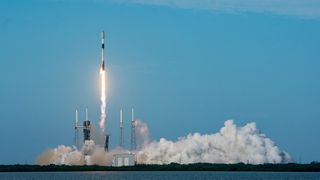SpaceX plans to launch 24 of its Starlink internet satellites from Florida early this morning (Nov. 14) on the second half of a spaceflight doubleheader.
A Falcon 9 rocket carrying the 24 Starlink spacecraft is scheduled to lift off from Florida's Cape Canaveral Space Force Station today during a four-hour window that opens at 5:33 a.m. EST (0933 GMT). That's just five hours after another Falcon 9 launched 20 Starlink satellites from Vandenberg Space Force Base in California.
SpaceX will webcast the liftoff live via X, beginning about five minutes before launch.
If all goes according to plan, the Falcon 9's first stage will return to Earth about eight minutes after liftoff today, landing on the SpaceX droneship "Just Read the Instructions," which will be stationed in the Atlantic Ocean.
It will be the 18th launch and landing for this particular booster, according to a SpaceX mission description. Nine of its previous 17 flights were Starlink missions.
The Falcon 9's upper stage, meanwhile, will haul the 20 Starlink satellites to low Earth orbit (LEO), deploying them there about 65 minutes after liftoff.
The huge and ever-growing Starlink megaconstellation, which currently consists of more than 6,560 active satellites, keeps SpaceX very busy these days.
Elon Musk's company has launched more than 100 Falcon 9 missions in 2024, about two-thirds of them dedicated to building out the giant broadband network in LEO.

.jpg) 21 hours ago
1
21 hours ago
1

 English (US)
English (US)